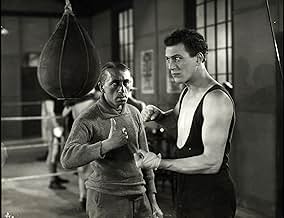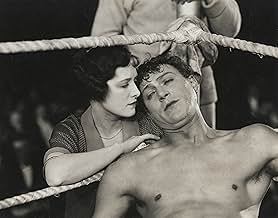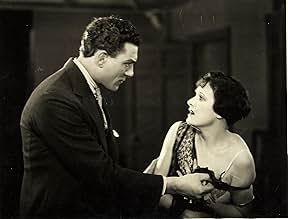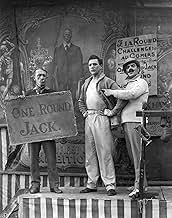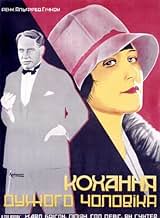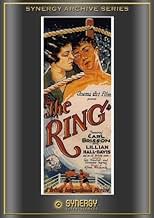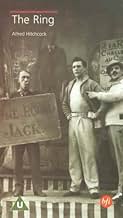CALIFICACIÓN DE IMDb
6.1/10
4.2 k
TU CALIFICACIÓN
Agrega una trama en tu idiomaTwo boxers compete for the love of a woman.Two boxers compete for the love of a woman.Two boxers compete for the love of a woman.
- Dirección
- Guionistas
- Elenco
Lillian Hall-Davis
- The Girl
- (as Lilian Hall Davis)
Eugene Corri
- Eugene Corri
- (sin créditos)
Charles Farrell
- Second
- (sin créditos)
Clare Greet
- Fortune Teller
- (sin créditos)
Lawrence Hanray
- Clerrgyman in Black Cassock
- (sin créditos)
Tom Helmore
- Spectator
- (sin créditos)
Alfred Hitchcock
- Man-Dipping Attraction Worker
- (sin créditos)
Minnie Rayner
- Boxing Contestant's Wife
- (sin créditos)
Brandy Walker
- Spectator
- (sin créditos)
Bombardier Billy Wells
- Boxer
- (sin créditos)
- Dirección
- Guionistas
- Todo el elenco y el equipo
- Producción, taquilla y más en IMDbPro
Opiniones destacadas
Hitchcock displays his already developed understanding for visuals in this early silent film. The plot of the film, involving two boxers fighting over a girl, is straight-forward drama without much to recommend it. Hitchcock's talent, though, is found in his stunning use of images. Nearly every shot is filled with visual symbols. Especially memorable is the jewelry that one boxer gives the girl just before she marries the other boxer. He slides it up her arm in a clearly sexual way and with one simple movement Hitch has shown us all we need to know. The boxing scenes are handled well with some interesting point-of-view shots that again prove how far ahead of his time Hitchcock was. The film also gives insight into his later treatment of women. The object of the boxers' desires is driven by money and lust, not reason or love. The only other women in the film are either beautiful party girls who make open offers of sex or old crones who help to destroy happy relationships. All in all, the Ring is a must for anyone interested in Hitchcock's early work and his development as a visual storyteller.
It's basically just a love-triangle story, but Hitchcock's storytelling skills and mastery of silent film techniques make "The Ring" well worth watching. There is a lot of visual detail and symbolism that add meaning to a basically routine story about small-time boxer Jack, his girl, and the champion who gives Jack his big break but who also tries to steal his girl.
The opening sequence establishes the triangle amidst the colorful atmosphere of a traveling show, where Jack takes on all comers inside a tent. It is filled with a lot of detail, especially the bracelet that Bob, the champion, gives to Jack's girl, which is important as a plot element and as a symbol. (This "ring" is one of several meanings of the film's nicely-chosen title.) Most of the plot that follows is predictable, as it is clear from the beginning that someday Bob and Jack will have to square off in the ring with more than Bob's title at stake. But if the story is routine, Hitchcock's technique is not. There are a lot of creative touches that develop the characters and story, and that add humor and interest. The cast is pretty good, and some of the secondary characters from the traveling show are very funny in the earlier scenes.
This is certainly an old-fashioned movie, and won't be of general interest today, but it's a nice little film. Anyone who likes silent films or who wants to see something quite different from the "Master of Suspense" should find this worth a look.
The opening sequence establishes the triangle amidst the colorful atmosphere of a traveling show, where Jack takes on all comers inside a tent. It is filled with a lot of detail, especially the bracelet that Bob, the champion, gives to Jack's girl, which is important as a plot element and as a symbol. (This "ring" is one of several meanings of the film's nicely-chosen title.) Most of the plot that follows is predictable, as it is clear from the beginning that someday Bob and Jack will have to square off in the ring with more than Bob's title at stake. But if the story is routine, Hitchcock's technique is not. There are a lot of creative touches that develop the characters and story, and that add humor and interest. The cast is pretty good, and some of the secondary characters from the traveling show are very funny in the earlier scenes.
This is certainly an old-fashioned movie, and won't be of general interest today, but it's a nice little film. Anyone who likes silent films or who wants to see something quite different from the "Master of Suspense" should find this worth a look.
The symbolic use of objects, form editing, the position of characters in the scene... these were all used with such joyous abandon by Hitchcock that you can really see what a fertile genius he had. The way the wife moves from one corner of the ring to the other as the fight progresses, the editing when the wedding ring is placed on her finger... while these may seem a bit obvious by todays standards, in the silent era they spoke volumes about the story without a word being spoken. Even the title has a least four meanings that I can see; the boxing ring, the wedding ring, the bracelet the lover buys, and the love triangle at the heart of the story.
This early film has its flaws-- a predictable plot and some overlong scenes of dubious relevance-- but it already clearly demonstrates Hitchcock's mastery of editing and the use of powerful images. It's also among the most expressionist of his films stylistically; note, for examples, the weird distortions he uses during the party sequence and the frequent echoes of both title and plot in the imagery.
Its core, though, remains the final match, which is still among the more exciting examples of cinematic boxing. Even though you know that the hero has to win, it becomes quite believable that he will lose, and the movement of his wife from the champion's corner to his, motivating the final plot pay-off, is very well entwined with the progress of the match. The inserts of the stopwatch do exactly what they should; you can almost hear the ticking (even though this is a silent film, the visuals often have a surprisingly auditory feel to them). The pacing becomes astonishingly rapid, and the viewer gets sucked into the excitement and brutality of both the match and the sexual jealousy which underlies it.
The only DVD release with which I am familiar is that of Laserlight, a public domain company. As with each Hitchcock silent they've released, they've attached various musical selections, mostly orchestral, to the action. The sound editing is frequently sloppy, and the sound quality varies widely, but some genuine care seems to have gone into most of the actual choices, and the music accompanying the final match works extremely well; it is unlikely that this sequence will ever be better accompanied than it is here.
This is a much more impressive film than its present obscurity would suggest. It deserves an honorable place in both the Hitchcock canon and the slender list of worthwhile boxing films.
Its core, though, remains the final match, which is still among the more exciting examples of cinematic boxing. Even though you know that the hero has to win, it becomes quite believable that he will lose, and the movement of his wife from the champion's corner to his, motivating the final plot pay-off, is very well entwined with the progress of the match. The inserts of the stopwatch do exactly what they should; you can almost hear the ticking (even though this is a silent film, the visuals often have a surprisingly auditory feel to them). The pacing becomes astonishingly rapid, and the viewer gets sucked into the excitement and brutality of both the match and the sexual jealousy which underlies it.
The only DVD release with which I am familiar is that of Laserlight, a public domain company. As with each Hitchcock silent they've released, they've attached various musical selections, mostly orchestral, to the action. The sound editing is frequently sloppy, and the sound quality varies widely, but some genuine care seems to have gone into most of the actual choices, and the music accompanying the final match works extremely well; it is unlikely that this sequence will ever be better accompanied than it is here.
This is a much more impressive film than its present obscurity would suggest. It deserves an honorable place in both the Hitchcock canon and the slender list of worthwhile boxing films.
"The Ring" is, for me, Hitchcock's best silent feature. It is a nippy little romance which sprints along with a surprisingly swift pace.
There's the typical early Hitch experimentation - the camera getting "knocked out" in a boxing scene is a prime example and some fine comedic moments in what is otherwise a pretty serious story of love and betrayal although, with the boxing backdrop, the rather mundane story is slightly more exciting.
Less gimicky than the more famous "The Lodger", and therefore more believable, "The Ring" is an underrated, early effort from the man who went on to become one of the most celebrated directors in the world.
NB. Catch hold of the BFI release of this video if you can - the score is superb and by far the best new music I have heard composed for a silent movie.
There's the typical early Hitch experimentation - the camera getting "knocked out" in a boxing scene is a prime example and some fine comedic moments in what is otherwise a pretty serious story of love and betrayal although, with the boxing backdrop, the rather mundane story is slightly more exciting.
Less gimicky than the more famous "The Lodger", and therefore more believable, "The Ring" is an underrated, early effort from the man who went on to become one of the most celebrated directors in the world.
NB. Catch hold of the BFI release of this video if you can - the score is superb and by far the best new music I have heard composed for a silent movie.
¿Sabías que…?
- TriviaAccording to the dialogue card at 1:19:06, the big fight between Jack Saunders and Bob Corby was refereed by Eugene Corri, who entered the ring wearing a tux. Corri made boxing history in December 1907 by being the first referee to referee inside the ring during a fight.
- ErroresDuring the first boxing scene, when the assistant is helping the sailor put on his coat, the coat is on nearly all the way; then, in the next shot, it is shown being put back on again.
- Citas
The Promoter: If you win this next fight with the nigger, you'll be in the running for the championship.
- ConexionesFeatured in Silent Britain (2006)
Selecciones populares
Inicia sesión para calificar y agrega a la lista de videos para obtener recomendaciones personalizadas
- How long is The Ring?Con tecnología de Alexa
Detalles
- Tiempo de ejecución
- 1h 56min(116 min)
- Mezcla de sonido
- Relación de aspecto
- 1.33 : 1
Contribuir a esta página
Sugiere una edición o agrega el contenido que falta

